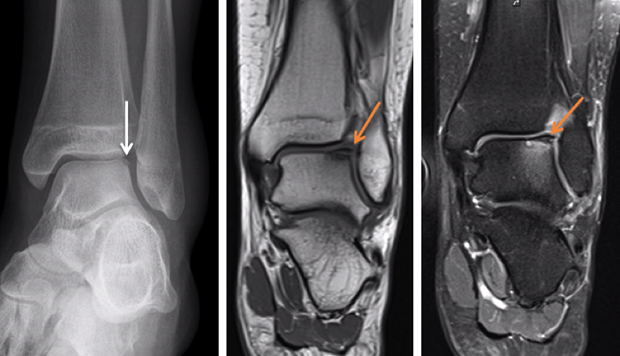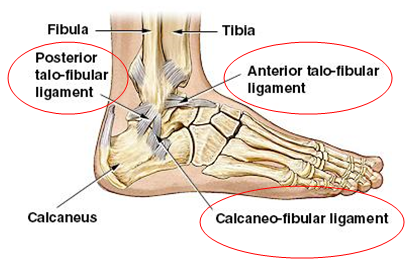Acute ankle sprains managed at Eastern Foot Care
The ankle is a hinge joint made up of 3 bones that allows movement up and down and a slight degree rotational movement. The bones that make up the ankle joint are the tibia (shin bone), the fibula (outside/lateral shin bone), and the talus or ankle bone.
There are 3 primary ligaments that stabilise the ankle joint and limit inversion/lateral rolling of the ankle joint and are susceptible to injury in an inversion ankle sprain. These ligaments are:
- The anterior talofibular ligament (ATFL)
- The calcaneofibular ligament (
- The posterior talofibular ligament (PTFL)
Other structures that can be injured in an inversion sprain include:
- The anterior tibiofibular ligament (ATIF) or ankle syndesmosis
- The peroneal tendons
- The 3 bones that comprise the ankle joint
- The bone attachments of the various ligamentous and tendon structures
Occasionally injury can be sustained the medial/inside ankle structures, although this is less common
ANKLE SPRAINS ARE A COMMON SPORTS INJURY
In sports inv olving rotational, twisting or pivoting movements the risk of an ankle sprain is relatively high. The Sports Podiatrists at Eastern Foot Care typically see ankle injuries in players participating in:
olving rotational, twisting or pivoting movements the risk of an ankle sprain is relatively high. The Sports Podiatrists at Eastern Foot Care typically see ankle injuries in players participating in:
- Netball and basketball
- AFL football, soccer and rugby
- Dance
Inversion ankle sprains can also occur from wearing poor footwear, walking on uneven terrain, or from relatively innocuous incidents including stumbling down steps.
CHARACTERISTIC SIGNS
An acute ankle sprain will typically involve any or all of the following:
- Pain (at the time of the incident or thereafter)
- Bruising
- Swelling
- Redness
- Warmth
- Reduced range of movement/stiffness
- Difficulty weightbearing
ASSESSING AN ANKLE SPRAIN
An inversion ankle sprain can result in injury to one or all of the ankle ligaments, and in some cases there can be damage to bone.
We classify the severity of the ankle sprain into 3 categories-
Grade 1 – over stretched/sprain
Grade 2 – partial tear of 1 or more ligaments
Grade 3 – complete tear/rupture of 1 or more ligaments
The mechanism of injury is the most important initial diagnostic tool as this can help to guide treatment going forward, including determining appropriate radiology if indicated. Depending on the nature of the injury and presenting complaint an x-ray, ultrasound or magnetic resonance imaging (MRI) scan may be warranted. All of these can be arranged by your Sports Podiatrist with Medicare rebates applicable for appropriate services.
Various clinical tests will also be conducted to further assess the integrity of the ankle joint and assist in guiding rehabilitation and return to sport.
MANAGEMENT
Initial management should follow the RICE principles of:
- Rest
- Ice
- Compression
- Elevation
Where appropriate the Sports Podiatrist may elect to utilise rigid strapping or a brace, and at times a CAM Walker or back-slab immobilisation cast is warranted.
As recovery progresses a full rehabilitation program will be implemented which is guided by progression of the injury and patient capabilities. Typically the focus will be on restoring range of motion, improving strength (particularly to the peroneal tendons) and regaining proprioception (balance).
Full recovery can take up to 12 weeks in some cases, and even longer in the event of a high-grade ankle sprain or injury to the talus bone. Occasionally surgery is warranted however even most Grade 3 ankle sprains can be managed conservatively.
In all circumstances it is recommended to seek the advice of a Sports Podiatrist for the appropriate assessment and management of an acute ankle sprain.
To make an appointment to see a Sports Podiatrist contact our team at Eastern Foot Care Knox on (03) 9887 2233 or Eastern Foot Care Ringwood on (03) 9870 1301.
